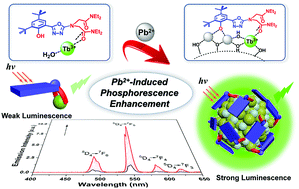A “turn-on” lanthanide complex chemosensor for recognition of lead(ii) based on the formation of nanoparticles†
Abstract
A functional amide-type pincer ligand was designed and synthesized, which could effectively capture Tb3+ ions to form a phosphorescence complex-based chemosensor Tb-1. The chemosensor could further coordinate with Pb2+ ions and display a turn-on phosphorescence response. This sensing process was analyzed in detail by steady-state luminescence spectroscopy, time-resolved luminescence spectroscopy, electron microscopy and dynamic light scattering, which suggest that the formation of Pb2+-induced hydroxide nanoclusters can adjust the optical signal of the external luminescence compound by embedment and fixation of Tb3+ complexes. Furthermore, Tb-1 could effectively eliminate the signal interference from the short-lived fluorescence and improve the signal-to-noise ratio to increase the accuracy of the detection for Pb2+. An understanding of the recognition mechanism of the Tb3+ complex-based chemosensor and the application of the characteristic spectra of lanthanide ions might be able to provide more opportunities to develop highly selective optical chemosensors.



 Please wait while we load your content...
Please wait while we load your content...